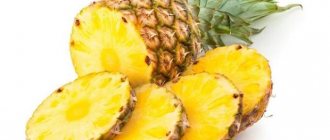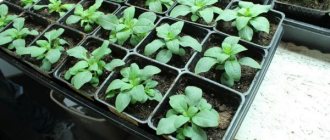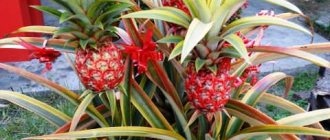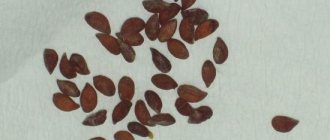Pineapple is a well-known tropical fruit that today is easy to find in the public domain and can be purchased at a relatively low price. But even better is to try growing it at home. To do this, you will need a ripe fruit with a healthy-looking top and a little patience.
It is generally accepted that pineapples need a special hot climate, which, of course, does not exist in the middle zone. However, in our latitudes they are successfully grown in greenhouses or indoor conditions. We will also focus on the second method of growing.
Pineapple grows well at temperatures of 22-25°C, but if it drops below 17°C, the plant will stop growing.
Where to get planting material
To grow pineapple, you need to choose the freshest possible fruit. Good signs are:
- no stains, soft spots, signs of mold or rot;
- leaves are fresh, completely green;
- sweetish fruity smell;
- the presence of a core in the rosette of leaves;
- The rosette area is dense and does not differ in structure from pineapple peel.
You should not take pineapple with wilted or dried leaves as planting material. If the leaves of a pineapple are severely pruned, then you should also discard it. Most often, sellers, by shortening the leaf crown, hide the signs of overripe fruit.
Unripe pineapple fruits take root faster and easier.
How to prepare fruit for planting
Sprouting pineapple from the top can be done in two ways:
- apical part;
- crown - a bunch of leaves with the core cut out.
Both methods are simple and have the same timing for the appearance of roots.
Helpful information
Daria Vorontsova
Amateur gardener. He is interested in growing various greens at home.
It is important to carefully follow the germination technique. Any mistakes can lead to the pineapple not giving roots and quickly rotting.
Germination from the apical part
Step by step procedure for growing pineapple from the top:
- The fruit selected for planting is thoroughly washed with soap, rinsed with a weak solution of potassium permanganate and dried with a clean towel or napkin. You cannot wash the cut crown.
- Using a sterile knife, cut off the crown along with the leaves 2.5 below the rosette.
- Carefully remove all the pulp, leaving the fibrous core.
- Sprinkle the cut area with crushed activated carbon and powdered growth stimulator.
- Leave the cut crown on a clean towel in a well-ventilated area. There must be constant access of air to the cutting site.
- After 2 days, a dense shell – callus – should appear on the cut.
Helpful information
Daria Vorontsova
Amateur gardener. He is interested in growing various greens at home.
Before planting, you can touch the cut area. If it is wet, the pineapple can be left to dry for another day. In this case, the surface should not be overdried; it simply should not be wet.
After the callus appears, the top of the pineapple can be rooted by planting in the ground.
Crown germination
There are two ways to separate the core:
- Unscrew the crown. To do this, firmly fix the fruit with one hand, and scroll it across the axis with the other, slightly pulling the pineapple down. With this method, a bunch of leaves along with the fibrous core are easily separated from the pulp.
- Cut out the core with a sterile knife. The cut is made as close to the leaves as possible. All the pulp is removed, leaving the core.
In both cases, the lower leaves are removed. To avoid damaging the plant, the leaves are removed one at a time. If the rosette is less than 10 cm, clean 1.5-2 cm, for large ones 2-2.5 cm.
The cut crown is placed in a well-ventilated dark place on a napkin to dry. Within 2 days, callus should appear at the cut site.
After the cut has tightened the crown, you can begin to germinate. To do this, pour clean water into a small transparent container and add a couple of activated carbon tablets. The pineapple crown is fixed in a container so that the cut is above the surface of the water without touching it. The roots appear within a week. When their number reaches 10 pieces and the length is at least 2 cm, the pineapple can be transplanted into the ground.
Diseases and pests
Pests usually avoid pineapple. But sometimes attacks from mealybugs or mites occur. In these cases, use special chemicals on the leaves and rinse them with water.
If a fungus grows inside the rosette, the leaves will turn black and begin to fall off. Apply the fungicide solution by pouring it directly into the core. When the cured plant produces a new leaf, the old and affected ones can be cut off.
Landing
Step 1: Choose a suitable pot
The height of the pot should be approximately 15 centimeters. Fill it with soil that is 30% organic matter. Also suitable soil for cacti. They, like pineapples, love one type of soil.
jimblog.me
Step 2: Plant the Top
When planting, make sure that only the stem and roots are in the ground. There is no need to cover the leaves with soil.
Step 3. Water the plant and leave in a warm place
After the first watering, monitor the condition of the soil - it should always be moist. To do this, water the plant at least once a week. The room temperature must be at least 18 °C. It is also important that the sprout receives plenty of sunlight. You can create a greenhouse effect by covering the pot with a plastic bag to speed up the growth of the pineapple.
birtop.ru
Propagation using root cuttings
Growing pineapple at home using root cuttings is more often practiced. Growing fruit this way is much easier than using seeds. But at the same time there should already be an adult plant at home.
For propagation, daughter shoots located at the bottom of the stem or under the infructescence are taken. The length of the cuttings should be at least 15 cm with several rows of leaves. The cuttings are rooted in the ground, and after new green leaves appear, they are transplanted to a permanent place.
How to stimulate flowering
If after several years the plant does not bloom, the process is accelerated using calcium carbide, which releases ethylene. A tablespoon is infused for a day in a closed glass container, then filtered. A rosette of leaves is filled with the resulting solution, 50 g each, for a week. After a month and a half, a peduncle usually appears. If the plant does not bloom, it has not reached maturity.
Other methods are to put a bag of apples in a bowl with pineapple or once a week to create smoke: leave smoldering paper and a smoking cigarette nearby, and cover the plant. Four procedures are done in a month.
Popular pineapple varieties
At home, you can grow pineapples for various purposes. Reproduction and care are carried out in the same way in all cases.
Pineapple bract
A popular variety of pineapple that has a remarkable feature: when exposed to the sun, its leaves acquire pink-reddish shades. The leaves reach a length of 1 m and have white and yellow stripes. Unlike other pineapples, this species lives for about 7 years. Often used as an ornamental plant. Suitable for breeding at home.
A special feature of the pineapple bract is the presence of stripes.
Pineapple Caena
The bush reaches a height of 0.3–0.5 m and has many dark green leaves. Suitable for planting at home, does not take up much space, and reproduces well by layering. Prefers porous, well-drained soils. The fruits are small, no more than 7–10 cm long and weighing within 0.5 kg, which can be used as food.
Caena pineapple fruits can be used as food
I didn’t grow anything on my windowsill, but now I want to tell you about the Caena pineapple.
This pineapple was given to me in the spring, on March 8th. The pineapple was beautiful, thick, with a beautiful rosette of small red flowers. After some period of time, a small pineapple fruit began to appear, at first green, then began to turn yellow; from the falling of the flowers to the appearance of the yellow fruit, probably half a year passed. The pineapple fruit tastes very, very sweet, soft, not like what is sold in the store. Of course, after peeling there was almost nothing left, but my whole family was able to try and appreciate it. The pineapple (green) itself is not tall, 20–25 cm. And the fruit was about 7 cm. Raspi
https://irecommend.ru/content/frukt-vyrashchennyi-doma
A little history
European nobility appreciated the exquisite and fresh taste of pineapples in the 16th century. However, overseas fruits then had exorbitant prices, so they quickly learned to grow them in greenhouses. In Russia, scientists grew pineapples in St. Petersburg and even further north on Solovki. Despite the fact that today these exotics are successfully imported from South America, lovers of indoor plants continue to grow them.
Pineapples are not picky about care and are quite viable. And with proper care, you can get a fruit-bearing plant from the top. Under natural conditions, the bushes have a size of 60-80 cm; in the room their size is slightly smaller.
Flowering, fruiting and propagation of pineapple at home: description
The soil is watered depending on how dry it is. Usually once every 2 weeks is enough. After all, pineapple is a heat-loving plant that tolerates drought well and does not tolerate copious amounts of moisture. In the summer, pineapple can be taken out to the balcony or loggia, but it should be protected from rain. It grows well next to tomatoes and cucumbers, but outside it is necessary to think of something with precipitation so that it does not fall on the plant under any circumstances.
Peculiarities:
- Flowering of pineapple , which is obtained from a rosette, begins after about two years. First, something like a red cone will appear in the core of the flower, from which a blue flower will bloom.











